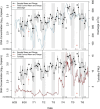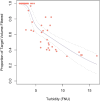Field Trials of an Autonomous eDNA Sampler in Lotic Waters
- PMID: 39540890
- PMCID: PMC11603765
- DOI: 10.1021/acs.est.4c04970
Field Trials of an Autonomous eDNA Sampler in Lotic Waters
Abstract
Environmental DNA (eDNA) analysis has become a transformative technology, but sample collection methods lack standardization and sampling at effective frequencies requires considerable field effort. Autonomous eDNA samplers that can sample water at high frequencies offer potential solutions to these problems. We present results from four case studies using a prototype autonomous eDNA sampler as part of the U.S. Geological Survey's Rapid Environmental eDNA Assessment and Deployment Initiative & Network (READI-Net) project. These case studies involved short-term deployments of an eDNA autosampler (Smith-Root) across a range of riverine habitats with the objectives of (a) identifying what insights could be gained from high-frequency autosampling and (b) benchmarking these autosamples against manually collected samples. The high frequency autosampling revealed high temporal variability of eDNA concentrations and provided valuable insights about eDNA associations with environmental covariates, such as discharge and turbidity. Benchmarking assessments indicated autosamples had similar detection rates to manual samples and obtained similar or greater eDNA quantities. We did find minimal carryover contamination in autosampler field controls. We conclude that eDNA autosamplers have potential to improve freshwater biosurveillance by reducing logistical sampling barriers, standardizing collection methods, and clarifying the influence of environmental covariates on eDNA results.
Keywords: Rainbow Trout; Round Goby; Spectaclecase; Western Pearlshell; Westslope Cutthroat Trout; invasive; robotic sampler; temporal.
Conflict of interest statement
The authors declare no competing financial interest.
Figures







References
-
- Kelly R. P.; Lodge D. M.; Lee K. N.; Theroux S.; Sepulveda A. J.; Scholin C. A.; Craine J. M.; Andruszkiewicz Allan E.; Nichols K. M.; Parsons K. M.; et al. Toward a national eDNA strategy for the United States. Environ. DNA 2024, 6 (1), e43210.1002/edn3.432. - DOI
-
- Larson E. R.; Graham B. M.; Achury R.; Coon J. J.; Daniels M. K.; Gambrell D. K.; Jonasen K. L.; King G. D.; LaRacuente N.; Perrin-Stowe T. I.; et al. From eDNA to citizen science: emerging tools for the early detection of invasive species. Front. Ecol. Environ. 2020, 18 (4), 194–202. 10.1002/fee.2162. - DOI
-
- Loeza-Quintana T.; Abbott C. L.; Heath D. D.; Bernatchez L.; Hanner R. H. Pathway to Increase Standards and Competency of eDNA Surveys (PISCeS)—Advancing collaboration and standardization efforts in the field of eDNA. Environ. DNA 2020, 2 (3), 255–260. 10.1002/edn3.112. - DOI
MeSH terms
Substances
LinkOut - more resources
Full Text Sources

